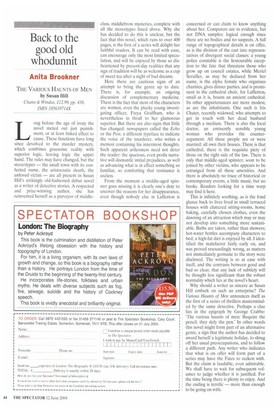Back to the good old whodunnit
Anita Brookner
THE VARIOUS HAUNTS OF MEN by Susan Hill Chatto & Windus, f12.99, pp. 438, ISBN 1856197I4X
ong before the age of irony the novel meted out just punishment, or at least linked effect to cause. These functions have long since devolved to the murder mystery, which combines gruesome reality with superior logic, leaving logic the upper hand. The rules may have changed, but the stereotypes — the small town with its confected name, the aristocratic sleuth, the unloved victim — are all present in Susan Hill's strikingly old-fashioned debut novel as a writer of detective stories. A respected and prize-winning author, she has reinvented herself as a purveyor of middle class, middlebrow mysteries, complete with all the stereotypes listed above. Why she has decided to do this is unclear, but the fact that this novel, which runs to over 400 pages, is the first of a series will delight her faithful readers. It can be read with ease, can encourage only the most limited speculation, and will be enjoyed by those so disheartened by present-day realities that any sign of tradition will be as welcome as a cup of sweet tea after a night of bad dreams.
Here there are cautious signs of an attempt to bring the genre up to date. There is, for example, an ongoing discussion of complementary medicine. There is the fact that most of the characters are women, even the plucky young investigating officer, Freya Graffham, who is nevertheless in thrall to her glamorous superior. But there are also signs that little has changed: newspapers called the Echo or the Post, a different typeface to indicate the voice of the murderer, who writes a memoir containing his innermost thoughts. Such apparent artlessness need not deter the reader: the spacious, even prolix narrative will dismantle initial prejudices, as well as advancing what is in effect something so familiar, so comforting that resistance is useless.
From the moment a middle-aged spinster goes missing it is clearly one's duty to uncover the reasons for her disappearance, even though nobody else in Lafferton is concerned or can claim to know anything about her. Computers are in evidence, but not DNA samples: logical enough since there are no bodies and no suspects. A full range of topographical details is on offer, as is the division of the cast into representatives of divergent social classes: a young police constable is the honourable exception to the fate that threatens those who grow up on council estates, while Meriel Serailler, as may be deduced from her name, is the alpha female who organises charities, gives dinner parties, and is prominent in the cathedral choir, for Lafferton, small as it is, boasts an ancient cathedral. Its other appurtenances are more modest, as are the inhabitants. One such is Iris Chater, recently widowed, who attempts to et in touch with her dead husband through a medium. There is also the local doctor, an eminently sensible young woman who provides the counterargument. All these people are or were married; all own their houses. There is that cathedral, there is the requisite piety of those on the right side of the law. There is only that middle-aged spinster, soon to be joined by other victims, who appears to be estranged from all these amenities. And there is absolutely no trace of historical or contemporary events, a little music, but no books. Readers looking for a time warp may find it here.
This is infinitely soothing, as is the fond glance back to lives lived in small terraced houses with cluttered sitting-rooms, home baking, carefully chosen clothes, even the dawning of an attraction which may or may not develop into something more sustainable. Baths are taken, rather than showers; hot-water bottles accompany characters to bed; a high-fat diet is enjoyed by all. I identified the malefactor fairly early on, and was proved resoundingly wrong, as matters not immediately germane to the story were disclosed. The writing is so at ease with itself, and the contrasts between good and bad so clear, that any lack of subtlety will be thought less significant than the robust normality which lies at the novel's heart.
Why should a writer as sincere as Susan Hill embark on such an enterprise? The Various Haunts of Men announces itself as the first of a series of thrillers masterminded by the same detective. Perhaps a clue lies in the epigraph by George Crabbe: 'The various haunts of men/ Require the pencil, they defy the pen.' In other words this novel might form part of an alternative genre, a sign that the author has decided to award herself a legitimate holiday, to shrug off her usual preoccupations, and to follow a different path. Any writer who indicates that what is on offer will form part of a series may have the Fates to reckon with. But the claim is laudable, even admirable. We shall have to wait for subsequent volumes to judge whether it is justified. For the time being there is plenty to enjoy. And the ending is terrific — more than enough to be going on with.


















































































 Previous page
Previous page